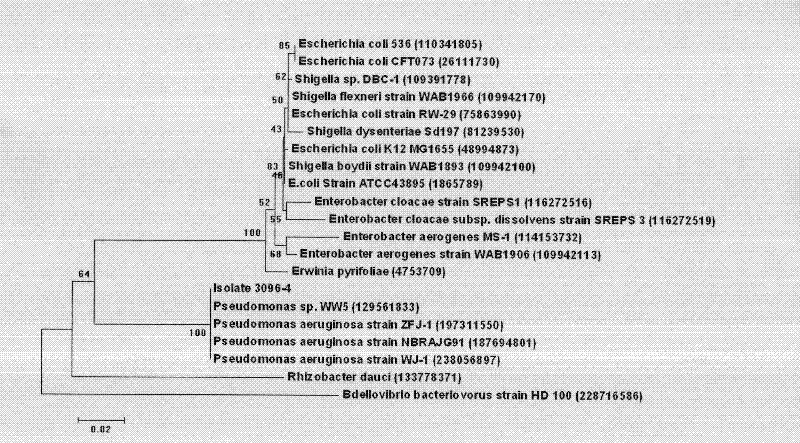Strain for degrading wool scale layer
A flake layer and wool technology, applied in the field of Pseudomonas, can solve the problems of increased protease process steps, time-consuming, increased cost, etc., and achieve the effects of avoiding environmental impact, mild working conditions, and good anti-felt performance.
- Summary
- Abstract
- Description
- Claims
- Application Information
AI Technical Summary
Problems solved by technology
Method used
Image
Examples
Embodiment 1
[0027] The new strain Pseudomonas sp. 3096-4 (Pseudomonas sp.3096-4) has been deposited in the General Microorganism Center of China Committee for the Collection of Microorganisms, and its preservation number is: CGMCC No.3888.
[0028] The source of the strain: the strain is derived from the rotten wool of the sheep farm in Songjiang, Shanghai. The specific isolation method is as follows:
[0029] (1) Enrichment Take 1g of rotten wool from the piled wool and place it in enrichment medium (0.5g of beef extract, 1g of peptone, 0.5g of sodium chloride, pH7.0-7.6), and culture at 28°C and 120 rpm 48h; then take 2mL of its culture solution and transfer it to enrichment medium 2, and further enrich and cultivate for 48h at 28°C and 120 rpm;
[0030] (2) Primary screening Take 100 μL of the final enrichment solution and spread it on the phosphoric acid digestion protein medium plate, and screen out the growing single colonies;
[0031] (3) Re-screening The bacterial strains obtaine...
Embodiment 2
[0057] In order to further enhance the industrial applicability of the protease liquid produced by the fermentation of Pseudomonas 3096-4, the present invention salts out and precipitates the fermented liquid, and after drying, dissolves it in a buffer solution to measure its anti-pilling effect. The specific operation method is to add 30% ammonium sulfate to the fermented enzyme solution of the monas 3096-4, place it at 4°C for 5-12 hours, centrifuge, remove the supernatant, freeze-dry, and set aside. When using, first use buffer (phosphate buffer or Tris-HCl buffer, pH 7.4-7.8), and dissolve to 0.5% (w / v). To treat the woolen cloth, the bath ratio is 1:30, act at 30°C for 50 minutes, wash and dry after treatment, and the felt shrinkage rate is 4.2%.
[0058]
PUM
 Login to View More
Login to View More Abstract
Description
Claims
Application Information
 Login to View More
Login to View More - R&D
- Intellectual Property
- Life Sciences
- Materials
- Tech Scout
- Unparalleled Data Quality
- Higher Quality Content
- 60% Fewer Hallucinations
Browse by: Latest US Patents, China's latest patents, Technical Efficacy Thesaurus, Application Domain, Technology Topic, Popular Technical Reports.
© 2025 PatSnap. All rights reserved.Legal|Privacy policy|Modern Slavery Act Transparency Statement|Sitemap|About US| Contact US: help@patsnap.com



